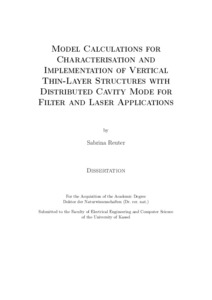| dc.date.accessioned | 2018-04-11T12:30:29Z | |
| dc.date.available | 2018-04-11T12:30:29Z | |
| dc.date.issued | 2018-04-11 | |
| dc.identifier.uri | urn:nbn:de:hebis:34-2018041155306 | |
| dc.identifier.uri | http://hdl.handle.net/123456789/2018041155306 | |
| dc.language.iso | eng | |
| dc.rights | Urheberrechtlich geschützt | |
| dc.rights.uri | https://rightsstatements.org/page/InC/1.0/ | |
| dc.subject | optical filter | eng |
| dc.subject | chirped grating | eng |
| dc.subject | surface emitting lasers | eng |
| dc.subject | optics | eng |
| dc.subject | thin layer deposition | eng |
| dc.subject | optical characterisation | eng |
| dc.subject.ddc | 500 | |
| dc.title | Model Calculations for Characterisation and Implementation of Vertical Thin-Layer Structures with Distributed Cavity Mode for Filter and Laser Applications | eng |
| dc.type | Dissertation | |
| dcterms.abstract | This work focusses on the approach of optical thin-layer filters with distributed cavity mode. Fabry-Pérot filters own a single cavity layer in the centre of the stack. In contrast, with chirped filter approach the cavity thickness is distributed over several layers. Model calculation results are applied to characterise the properties of the spectrum and the electric field of chirped filters. The aim of distributing the cavity within the filter stack is to distribute the electric field in the resonance case (transmission line) and thereby achieve laser applications that have a reduced local electric field but broaden along the filter length, as is required in a coreSEL. This laser approach aims to reduce undesired side-effects due to high electric field strengths, as it
is known from VCSEL applications.
In this work the hypothesis of a distributed electric field mode is proven by ap- plying a triangular chirp function to the layer thicknesses. The distribution of the electric field is increased in comparison to a Fabry-Pérot filter. Direct com- parison results in similar reflectivity spectra of chirped filters and Fabry-Pérot filters. However, they behave similarly but not identically. These differences are analysed by chirped reflectors of linear chirp. Aside from that, the reflec- tivity and the electric field depend on the spectrum and the design parameters of the filters. Furthermore, an efficient and targeted design strategy is pre- sented, which is required due to an increased number of design parameters for chirped filters. Finally, the challenges of realisation of chirped filters are discussed and an example for successful implementation and characterisation of a chirped filter is presented. | eng |
| dcterms.accessRights | open access | |
| dcterms.creator | Reuter, Sabrina | |
| dc.contributor.corporatename | Kassel, Universität Kassel, Fachbereich Elektrotechnik / Informatik | |
| dc.contributor.referee | Kusserow, Thomas (Prof. Dr.) | |
| dc.contributor.referee | Witzigmann, Bernd (Prof. Dr.) | |
| dc.subject.pacs | Optics | ger |
| dc.subject.pacs | Electronic and magnetic devices; microelectronics | ger |
| dc.subject.pacs | Other areas of applied and interdisciplinary physics | ger |
| dc.subject.pacs | Optical properties, condensed-matter spectroscopy and other interactions of radiation and particles with condensed matter | ger |
| dc.subject.swd | Optisches Filter | ger |
| dc.subject.swd | VCSEL-Laser | ger |
| dc.subject.swd | Dünne Schicht | ger |
| dc.date.examination | 2018-01-19 | |

